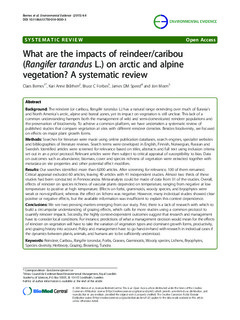| dc.description.abstract | Background:The reindeer (or caribou,Rangifer tarandusL.) has a natural range extending over much of Eurasia’s
and North America’s arctic, alpine and boreal zones, yet its impact on vegetation is still unclear. This lack of a
common understanding hampers both the management of wild and semi-domesticated reindeer populations and
the preservation of biodiversity. To achieve a common platform, we have undertaken a systematic review of
published studies that compare vegetation at sites with different reindeer densities. Besides biodiversity, we focused
on effects on major plant growth forms.
Methods:Searches for literature were made using online publication databases, search engines, specialist websites
and bibliographies of literature reviews. Search terms were developed in English, Finnish, Norwegian, Russian and
Swedish. Identified articles were screened for relevance based on titles, abstracts and full text using inclusion criteria
set out in ana prioriprotocol. Relevant articles were then subject to critical appraisal of susceptibility to bias. Data
on outcomes such as abundance, biomass, cover and species richness of vegetation were extracted together with
metadata on site properties and other potential effect modifiers.
Results:Our searches identified more than 6,000 articles. After screening for relevance, 100 of them remained.
Critical appraisal excluded 60 articles, leaving 40 articles with 41 independent studies. Almost two thirds of these
studies had been conducted in Fennoscandia. Meta-analysis could be made of data from 31 of the studies. Overall,
effects of reindeer on species richness of vascular plants depended on temperature, ranging from negative at low
temperature to positive at high temperature. Effects on forbs, graminoids, woody species, and bryophytes were
weak or non-significant, whereas the effect on lichens was negative. However, many individual studies showed clear
positive or negative effects, but the available information was insufficient to explain this context dependence.
Conclusions:We see two pressing matters emerging from our study. First, there is a lack of research with which to
build a circumpolar understanding of grazing effects, which calls for more studies using a common protocol to
quantify reindeer impacts. Secondly, the highly context-dependent outcomes suggest that research and management
have to consider local conditions. For instance, predictions of what a management decision would mean for the effects
of reindeer on vegetation will have to take the variation of vegetation types and dominant growth forms, productivity,
and grazing history into account. Policy and management have to go hand-in-hand with research in individual cases if
the dynamics between plants, animals, and humans are to be sufficiently understood.
Keywords:Reindeer, Caribou,Rangifer tarandus, Forbs, Grasses, Graminoids, Woody species, Lichens, Bryophytes,
Species diversity, Herbivory, Grazing, Browsing, Tundra | nb_NO |
